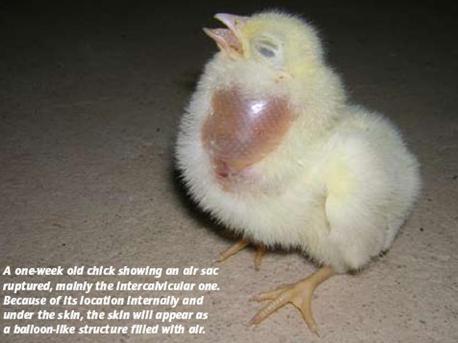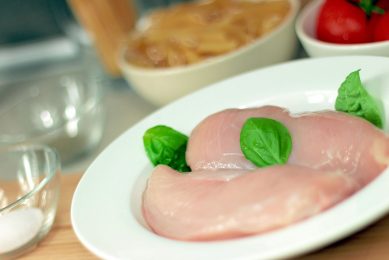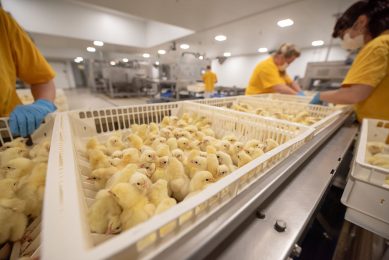Rising pressure from air sacculitis

During their first week of life, broiler chicks may show severe swelling below the neck area. This is usually recognised as air sacculitis. Even though symptoms may be relieved and the chick can live a productive life, this is often not the case.
By Ismail Suliman, Khartoum, Sudan
What is wrong with a broiler chick, one week of age, suffering from pain with its eyes closed and apparently unable to stand or move? A close look reveals that there is a distension of skin appearing as a “ball” just below the neck area. For further and better investigation the tiny feathers over this distended area are removed and the effected area appeared as a balloon-like structure filled with air. When punctured with a needle, the air quickly escaped, however, the collapsed “balloon” soon started to fill again to the initially distended size.
High oxygen demand
Due to the high metabolic rate required for flight, birds have a high oxygen demand. It is said that the development of an efficient respiratory system has enabled the evolution of flight in birds.
Birds ventilate their lungs by means of air sacs, which is a structure unique to birds. Basically, there are four pairs of air sacs in chickens that reach from the neck to the abdomen and open into the pneumatic bones. The air sacs are made of a delicate, thin wall and collapse when the chest is opened, so they may be difficult to see. These sacs do not play a direct role in gaseous exchange, but to store air and act like bellows, allowing the lungs to maintain a fixed volume with fresh air constantly flowing through them.
Three distinct sets
So, generally speaking there are three distinct sets of organs that perform respiration in chickens: the interior air sacs (cervical, calvicular, cranial), the lung, and the posterior air sacs (caudal and abdominal). In domestic chickens, the following air sacs are recognised:
• Single cervical air sac with vertebral diverticula.
• Single intercalvicular air sac, laying at the thoracic inlet, is formed by fusion of four embryonic sacs in most species, having both intrathoracic and extrathoracic diverticula. The latter passes along the shoulder joint and the pectoral girdle, giving off the pectoral, humeral and axillary diverticula.
• Paired cranial thoracic air sacs.
• Paired caudal thoracic air sacs.
•Paired abdominal air sacs with perirenal and femoral diverticula in many birds. They represent a series of compressed, irregular, thin-wall, potential spaces intermingling with intestinal coils.
Role of the air sacs
Both the interior and the posterior air sacs expand during inhalation. Air enters the birds via the trachea; half of the inhaled air enters the posterior air sacs, and the other half passes through the lungs and into the interior air sacs. The sacs contract during exhalation, air from the interior air sacs empties directly into the trachea and out the bird’s mouth or nares. The posterior air sacs empty their air into the lung. Air passing through the lungs as the bird exhales is expelled via the trachea. Because fresh air flows through the lung in only one direction, there is no mixing of oxygen-rich air and oxygen-poor, carbon dioxide-rich air as in mammalian lungs. Thus, the partial pressure of oxygen in birds’ lungs is the same as the environment, and so birds have more efficient gas-exchange of both oxygen and carbon dioxide than mammals.
General air sacs function
According to studies done on domestic chickens and turkeys, the function of the air sacs can be summarised as follows:
• Increase pulmonary ventilation and exchange of gases.
• Decrease the specific gravity of the body, thus facilitating flying.
• Regulate body temperature by cooling and warming inspired air.
• Closeness of abdominal air sacs to testes might facilitate spermatogenesis.
• Humidify inspired air.
• Receiving and then delivering a flow of air through the respiratory passages.
• Pneumatize bones facilitating aerial locomotion.
• Thermal regulation of the body in general.
Diagnosis of ruptured air sacs
Because of the presence of the air sacs beneath the skin, an air sac ruptured can be realised as a bulging and swelling of the skin layer. Consequently, and for a better diagnosis, one may push a sterile needle through the skin. If air is present beneath the skin, the swelling will diminish. However, if it is oedema, a fluid can be aspirated through the needle. In most chicks with this problem, the air sac wall will eventually heal and the subcutaneous air will disappear. Nevertheless, many chicks may die.













